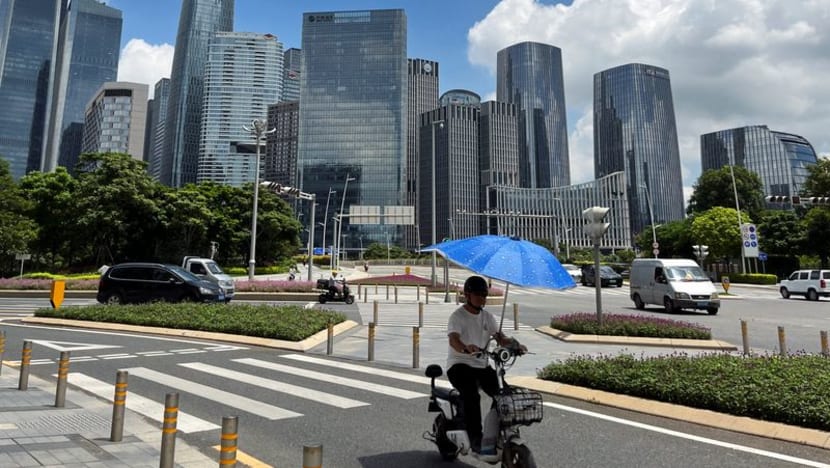How successful has China's Greater Bay Area been?
As China continues to invest in the Greater Bay Area, more efforts have also been made to improve its connectivity.

A man rides a scooter past a completed central area of Qianhai new district in Shenzhen, Guangdong province, China August 25, 2023. (File photo: REUTERS/David Kirton)

This audio is generated by an AI tool.
SHENZHEN: China’s Greater Bay Area (GBA) is lucrative, with its combined gross domestic product (GDP) of 14 trillion yuan (US$2 trillion) last year - larger than that of the whole of South Korea’s.
But some areas have not yet realised their potential, said observers. Among them is Qianhai, a district within the southeastern city of Shenzhen.
Shenzhen and eight other municipalities in Guangdong province, along with the two special administrative regions of Hong Kong and Macao, form the Greater Bay Area.
The GBA was established by China in 2019 as part of the country’s national economic development strategy.
The megalopolis, with a population of over 86 million people, generated about 11 per cent of China's GDP last year.
Qianhai is attractive on paper - situated near an airport and connected by bridge to Hong Kong. It was once even hailed as the next Hong Kong, but proposals to realise such an ambition failed as plans for open information access fell through.
The district’s appeal soon waned against the rise of central Shenzhen, where many foreign businesses are now concentrated.
Qianhai is now trying to revive development by giving tax subsidies to eligible firms, and to Hong Kong residents working in the zone.
Medical robotics firm PokField Technology, which was started by students from the University of Hong Kong's new tech academy, is among the companies that have put roots in Qianhai for its favourable business environment.
“From the aspect of tax, as well as from the aspect of rent, there is a great advantage for us.” said its co-founder Duanmu Dehao.
In 2023, Qianhai achieved a GDP of about US$35 billion, a year-on-year increase of 15 per cent.
THE EVOLUTION OF GUANGDONG
As China’s first special economic zone, Shenzhen - which is sometimes referred to as China’s Silicon Valley - has set a high bar. Its GDP has now surpassed that of first-tier cities Beijing and Shanghai.
The nature of Shenzhen’s economy is changing as Guangdong sheds its reputation as the world’s factory. The province has shifted its focus from heavy production lines to e-commerce.
Mr Kevin Wang, who hails from Anhui province, co-founded 3D printing start-up Elegoo in 2015 in Shenzhen. He has seen the changing face of the city through the years.
“Now, more and more, I see (that) a lot of entrepreneurs, especially (in) Shenzhen, are talking about creating their own brand, (and) how to make that brand more popular,” he said.
Mr Wang, whose firm has seen success as far away as the United States, noted that the city has incentives for firms that build their own brand - they get monetary rewards for achieving high yearly revenues.

DEEPER CONNECTIVITY IN THE GBA
As China continues to invest in the Greater Bay Area, more efforts have also been made to improve its connectivity.
The goal is to achieve a “one-hour living circle”, which would mean getting anywhere in the GBA within an hour to encourage the flow of people.
For instance, a new 24km bridge has cut travel time between Shenzhen and Zhongshan by more than half. The US$6.7 billion mega-structure has eight lanes, two bridges, two artificial islands and an undersea tunnel.
When CNA took the High Speed Rail from Hong Kong to Shenzhen North Railway station, the commute, excluding time taken to clear border checkpoints, took only 18 minutes.

The GBA's economic success means that investors have remained interested despite geopolitical challenges.
For example, Singapore bank DBS has opened close to 600 individual wealth accounts and 700 small- and medium-size enterprise (SME) accounts every month in Hong Kong. The accounts belong mainly to clients in the GBA.
In an interview with CNA, DBS' Head of North Asia Sebastian Paredes noted the evolution of new industries in the Greater Bay Area such as electric vehicles, solar panels and circuits.
“With global tensions affecting the area, we have seen Chinese entities willing to diversify their supply chain, especially in ASEAN (Association of Southeast Asian Nations) countries. That's the area where we can help a lot,” said Mr Paredes, who is also CEO of DBS Hong Kong.
For instance, the US has slapped higher tariffs on some Chinese imports, including electric vehicles.
Professor Heiwai Tang, director of think tank Asia Global Institute, told CNA’s East Asia Tonight that China’s economic transformation and technological advancements, including in the GBA, will likely lead to more friction between Beijing and Washington.
He said he hopes to see more “functional decoupling” between the US and China.
“On technologies, I'm not hoping that there will be collaboration between US companies and Chinese companies. But on sustainability and traditional manufacturing, I hope that the two countries will see each other as partners rather than competitors,” he said.



















